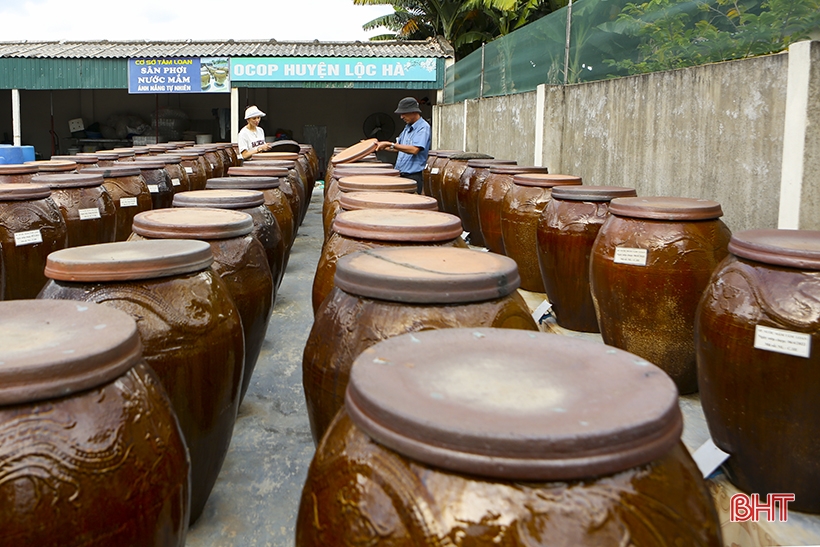My village is a coastal village in Thach Kim commune (Loc Ha - Ha Tinh ) that has been making fish sauce since ancient times, but it is mainly a small-scale craft. Each family marinates a few jars of fish sauce, and mothers pass on the craft to their daughters, just like the secret of making Van village wine.
Thach Kim fishing village (Loc Ha) in the early morning. Photo by Tien Dung.
A few years ago, a fish sauce complex was organized on a fairly large scale with nearly 100 earthenware jars, each jar could hold 200 kg of fish. The owner of this complex was a slim but agile and resourceful woman. She was Phan Thi Mai - President of the Women's Union of Thach Kim Commune (Loc Ha).
I met her on a rainy Sunday, the sea was rough, and I had nothing to do. Looking at the rows of earthenware jars with carefully covered lids arranged in long rows marking the specific time of salting fish sauce, with a rubber hose attached to suck up the fish sauce essence, I asked Mai: Why is our fish sauce called Sành? Mai smiled: At first, I intended to name it Ngoc Tich fish sauce to commemorate my hometown, because our fishing village had an old name called Ngoc Tich. But later, I found this name too beautiful and did not leave a strong impression, so I named it Sành, short and arousing the curiosity of users. Sành is fish sauce stored in earthenware jars; Sành also means inviting gourmets to use this "magical" water to enjoy the taste of the sea. This is the honey of the sea distilled from the sun, from the wind, and with the "cool hands" of women.
Ms. Phan Thi Mai's Sanh fish sauce production facility (second from left) is rushing to complete procedures to be recognized as meeting OCOP standards.
Yes, “good hand”, I felt excited when hearing Mai speak with such natural, proud and kind praise for the fishing village women. “Good hand” not only refers to a resourceful person but also contains dexterity, carefulness, thoughtfulness and especially long-standing folk experience. Mai said that her family has a tradition of making fish sauce from grandparents to parents and now it is the turn of her grandchildren. Mai’s grandfather used to specialize in making wooden barrels of loi to sell to fish sauce makers. Mai’s mother is a famous fish sauce maker in this area but in small quantities, mainly for personal use. Only Mai’s generation was bold enough to invest, first in a warehouse, then mobilized her sisters to work together.
The first factor to make good fish sauce is the container for the fish sauce. In the past, our ancestors used wooden barrels, but now wood is becoming scarce, so we have to use jars or cement barrels. After consulting, Mai chose a ceramic jar ordered from Ninh Binh . The main material of the jar is baked clay, each one costs nearly 2 million VND. Unglazed ceramic jars ensure that water does not leak, the fish sauce is very delicious, retains its characteristic flavor, and is highly durable. Mai said that after cleaning the jar, a layer of gravel is placed at the bottom to filter the clarity, then a bamboo mat is placed on top and the fish mixed with salt is added. On top, a bamboo mat is used to secure the latch, then heavy stones are placed on top, then a gauze is used to cover the mouth of the jar to prevent flies and mosquitoes. Mai also said that despite careful selection, sometimes the jars are cracked, so the fish sauce must be transferred to another jar and used to store salt.
Fish sauce is salted in earthenware jars by the people of Loc Ha fishing village.
Salt - that is a very important ingredient after fish. Salt to make good fish sauce must be pure, stored in a warehouse for at least a year to dry before use. The longer the salt is dried, the more "aged" it will be to produce the perfect fish sauce, delicious, sweet and smooth. Mai ordered salt from Ho Do, a place with a long tradition of salt making. Good salt is the type of large, white grains, stored for a long time so it is less astringent. To have a delicious fish sauce, not bitter or harsh, when marinating fish, the salt must go through a drying process, at which time the salt is no longer "sour" but becomes "dry" because the water vapor and metal radicals have been completely removed. If the salt is not "ripe", the color and flavor of the fish sauce will change immediately. This salt is called clean salt, distilled from the sun, wind, soil and the salty sweat of salt workers who "sell their faces to the earth, their backs to the sky", choosing the hottest days to expose themselves to the salt fields to produce salt crystals that sparkle like diamonds.
I picked up a handful of salt and felt the shimmering, radiant taste of the sea. The salt seemed to permeate through the skin of my hands, feeling the warm, passionate, and concentrated flavor of the ocean. Even the bamboo mats used to arrange the fish in the jars, Mai had painstakingly gone all the way to Thach My, where there were old bamboo clumps, to order. The flexible bamboo slices were soaked thoroughly and dried in the sun, then skillfully polished by her hands to create durable bamboo mats that could withstand the pressure of the ballast and the salty taste of salt and fish. The bamboo mats did not break or erode, but the tighter they were, the more flexible and durable they became.
The story of Sanh fish sauce became more and more flavorful as I asked Mai about the most important ingredient that determines fish. Actually, there are many types of fish to make fish sauce, but for a long time, fishermen often choose anchovies. Every year, there are usually two anchovy seasons: the first from January to February (lunar calendar), the second from July to August (lunar calendar). There are many different types of anchovies such as: striped anchovies, charcoal anchovies, red anchovies, flat anchovies... But the most delicious is charcoal anchovies with a black stripe in the middle of the body. Mai said: I usually choose to buy the whole boat when it just docks and mobilize my sisters to bring the fish back to ferment in time. In particular, the fish must be washed clean with seawater, the fish skin still glitters with phosphorescence.
The process of salting fish sauce is very elaborate. Mai shared: This is the unique experience of each place to ferment salt and fish in a certain ratio depending on the fishing ground and season. The common method to have good fish sauce is the stirring process. Each jar has a water discharge tap. When the water in the fish flows out, in the morning you have to open the lid to let the light in, at the same time drain the water in the jar into a stainless steel basin and dry it until evening, then pour it in, which is called the fermentation process. If the weather is hot, you only need to stir for 2 months, but if the weather is not favorable, you have to extend it. When salting fish, divide the fish into small pieces, put them in a stainless steel pan and stir them directly by hand with salt, absolutely hygienic. I asked Mai: How to recognize good fish sauce? Mai said: It is fish sauce with a characteristic sweet aroma, not strong; when tasted, it has a sweet taste; about the color: golden brown, when poured into a glass bottle, the fish sauce will float.
My hometown fishing village has a way to test good fish sauce with cold rice with a simple operation: Just drop cold rice grains into the fish sauce. If you see the rice grains sink to the bottom, it is not good fish sauce. If the rice grains float, it is a bottle of good fish sauce without chemicals. There is a strange thing according to folk experience, before going into the water, divers often drink fish sauce, especially the essence. That is because fish sauce has many substances that provide energy to keep the body warm, help divers feel less cold and prevent blood clotting, help increase heart rate and blood pressure, and resist water pressure.
One thing that surprised me and I couldn’t explain was that when a funeral passed by, the locals often took a handful of soil and covered the jar lid and used lime to mark the outside of the jar to prevent the fish sauce from “turning” – changing color and smelling bad. Through learning about the fish sauce industry, Mai also gave me some tips for using fish sauce in cooking. That is, don’t add fish sauce to the dish before turning off the heat; don’t marinate meat with fish sauce as it will make the meat tough; with soups, meat, stir-fries, you should only add fish sauce at the end before removing it from the stove for about a minute to retain the nutrition and sweetness of the fish sauce.
Ms. Phan Thi Mai (far left) received the encouragement prize of the 2022 Women's Startup Ideas Competition. Photo: Thien Vy.
Late afternoon, Mai walked along the row of fish sauce jars. She gently stroked each jar with her hand, considering them as her children that she cared for and watched over every day. That was also her joy, and the joy of the women who created the Sanh fish sauce brand from my hometown. It is known that she was awarded an encouragement prize by the Ha Tinh Women's Union at the "Women's Entrepreneurship Ideas" contest in 2022.
Ha Tinh, November 2023
Nguyen Ngoc Phu
Nguyen Ngoc Phu
Source































































































Comment (0)